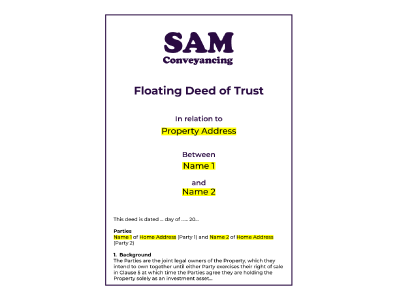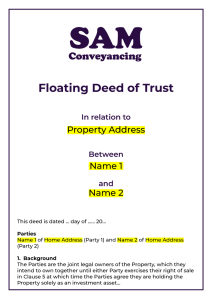Floating Deed of Trust
A floating Deed of Trust, also known as a commensurate share deed, allows joint owners to own a higher share of the property's beneficial interest based on the contributions toward the property. The calculator shows the more you put in, the more you'll get out on sale or transfer.
As you'll have seen from our article about Deeds of Trust, joint owners often look only to protect their money used to buy the property in a declaration of trust; either with a fixed beneficial interest or by returning the original deposits and sharing any net proceeds thereafter equally.
Both of these are fine if the relationship remains static and both joint owners pay their share of the costs of the property, but what happens if they don't? Who pays the mortgage if one of the joint owners moves out? Does this increase your beneficial interest? Read on for a detailed review of how to draft a Deed of Trust that allows for a commensurate share of the beneficial interest based on what you invest into the property. Below, we answer some of our clients' most frequently asked questions.
It is important to note that you cannot hold property on trust in unequal or floating shares using a deed if you are registered as joint tenants. You must be tenants in common. Read more on How to change from Joint Tenants to Tenants in Common and How to confirm if you are joint tenants or tenants in common.
Protect your interest in a property and confirm how to sell. Drafted by a solicitor.
The first draft is within 1 to 2 working days* and includes:
- Deposit paid, costs of purchase, mortgage repayments and renovations.
- How to share property expenses, including the mortgage and bills.
- Share of property income - rent or gain on sale.
- How to sell the property.
Unlike a basic declaration of trust that states a fixed beneficial interest, a floating deed can take into account a variety of costs linked to the property that add value and can increase your beneficial interest.
- 1Original Purchase Deposit
The joint owner's original contribution toward the deposit to purchase the property is reflected in the deed. The larger the deposit, the greater your beneficial interest will be at the start. Where one owner puts in 100% of the deposit, over time, if the other owner pays money toward the costs of purchase, mortgage, and renovations, then the 100% will be reduced to reflect the other owner's contributions.
- 2Cost of Purchase
The original share each owner paid towards the costs to buy the property such as:
- Stamp Duty Land Tax
- Legal Fees
- Land Registry Fees
- Home Survey
- Conveyancing searches
- Mortgage application fees
- 3Mortgage Repayments
The joint owners can agree to share the mortgage repayments in unequal shares to allow a person paying more per month than the other to grow a greater beneficial interest in the property. It is often the case that one of the joint owners will pay more of the mortgage based on their financial position. By doing so, with a fixed share deed, the joint owner would be paying more and not getting a benefit; however, with a floating deed, they can see a return on their additional payments. Unlike the purchase deposits, mortgage repayments will be made every month over several years so it is advisable to log the mortgage repayments so you have this to calculate your beneficial interest on sale.
A floating deed better suits unmarried couples in this regard. If the relationship breaks down and one person moves out and stops paying their share of the mortgage, the remaining owner can grow a greater share in the property until they sell. Read more - Splitting up with partner...Who must pay the mortgage?
- 4Renovations
Contributions to renovations or repairs that add value to the property can increase your financial stake. These payments can be considerable - building an extension isn't cheap - so logging who paid for what is essential and within the deed can be used to increase a joint owner's beneficial interest then. Not all renovations add value and, as such, don't increase your beneficial interest. Read more - What renovation works add value to your home?.
It is often noted within a floating deed the share by which the household bills will be split; however, it is rarely used in the calculation for beneficial ownership. This cost is seen as maintenance or upkeep rather than increasing value. It is also hard to definitively say what costs fall into this category and who should pay for them because of the benefit they provide; broadband. insurance? food? mobile phone? Who is using these more and increasing the cost? While it's important to document who pays for the household costs and in what shares, these aren't used for calculating an increase in beneficial interest.
How is the floating share calculated?
There is a formula used within the deed that a solicitor will use to distribute the net proceeds of sale or the share transfer price. You will need to provide to the solicitor the evidence for the payments made toward the property - not all of the above are always included so you agree with the solicitor who drafts the deed for you which of the above you want to take into consideration.
Pros and Cons of a Floating Deed of Trust
Pros | Cons |
|
|
Andrew started his career in 2000 working within conveyancing solicitor firms and grew hands-on knowledge of a wide variety of conveyancing challenges and solutions. After helping in excess of 50,000 clients in his career, he uses all this experience within his article writing for SAM, mainstream media and his self published book How to Buy a House Without Killing Anyone.
Caragh is an excellent writer and copy editor of books, news articles and editorials. She has written extensively for SAM for a variety of conveyancing, survey, property law and mortgage-related articles.










